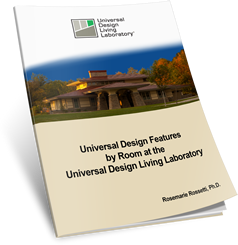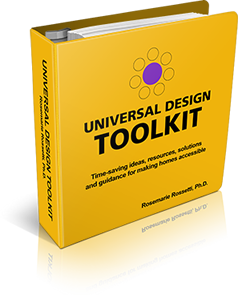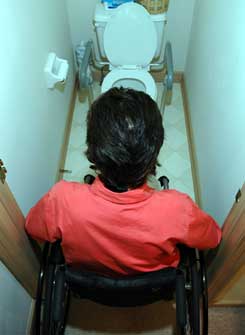
Discover how to live at home more affordably -- with independence, safety and dignity.
Get a sneak-peek at the "Universal Design Toolkit" with this free chapter filled with advice, tips and money-saving resources!

Build your awareness of what universal design features should be incorporated into homes.
Get the newly released "Universal Design Tookit", based on this real life demonstration home.

|
|
Article:
Simple Steps to Make Your Bathroom Wheelchair AccessibleAction Magazine
November 2007
By Rosemarie Rossetti
Copyright © 2007 Rosemarie Rossetti
Publication copyright © 2007 United Spinal Association
|
 In July 1998, when I first came home from the hospital after my spinal cord injury, I realized that my wheelchair would never fi t into our bathroom’s 3’ x 5’ toiletting area; with the door attached, the door clearance was only 26 inches. I looked at the glass-enclosed shower and whirlpool bathtub and wondered how I would ever gain access. Life after my spinal cord injury was not going to be easy.
In July 1998, when I first came home from the hospital after my spinal cord injury, I realized that my wheelchair would never fi t into our bathroom’s 3’ x 5’ toiletting area; with the door attached, the door clearance was only 26 inches. I looked at the glass-enclosed shower and whirlpool bathtub and wondered how I would ever gain access. Life after my spinal cord injury was not going to be easy.
My husband Mark and I built our home three years before my injury. We did not want to do any remodeling until we were sure about the permanent extent of my injuries. We were hopeful that someday I would not need the wheelchair; so we only wanted to make simple changes to improve the bathroom’s accessibility.
At the advice of an occupational therapist, we installed full extension shelves and baskets under the sink so that I could access all items stored there. Since there are cabinets under the sink, I approach it sideways in order to use it. Ideally I would like to be able to approach a sink facing it and have knee space under it.
Mark took the two sliding doors off the shower and replaced them with a curtain. We bought a transfer shower bench so that I could independently take a shower. The problem is that when Mark takes a shower, he needs to store the shower bench in the bathtub. This means that he must remember to set up the bench for me.
Mark also replaced the shower nozzle with a hand held model that has a 7-foot long hose, on/off button, and wall-mounting bracket. When Mark finishes taking a shower, he has to remember to move the shower head from a bracket mounted 7½ feet from the floor to one 3 feet from the floor. If he forgets and is not at home, I need to use a long-handled reacher and stay clear as the dislodged nozzle comes crashing down.
Many of the towel bars are 5 feet from the floor and not convenient for me to reach. My solution is to drape towels on the edge of the bathtub. If it is possible to lower towel bars within reach, this can be a better solution.
The bathtub is tricky for me to get into. I transfer from my wheelchair to the edge of the tub and swing my legs inside. Ideally it would be great if there were grab bars in convenient places. The only grab bars are inside the tub so I hold onto the framing around the shower enclosure as I make my transfer. We put a nonskid mat in the bottom of the tub for safety. A long-hosed adaptive sprayer fits over the faucet outlet. This allows me to more easily wash my hair.
The door to one of the closets had to be removed for wheelchair access. For items stored on the taller shelves in the closet, I use a long- handled reacher. We moved many of my clothes to the lower shelves in the closet and packed some of them away. The clothes on hangers were moved to the rods within my reach, and for those clothes on the upper rods, I use my reacher.
We installed two raised toilet seats with integrated grab bars for the toilets in the master bath and half bath. By removing the door to the toileting room in the master bath, we gained a few inches for access, however I lost all privacy. Privacy is also lost in the 4.5’ x 5.5’ half bath since my wheelchair sticks out in the hallway when I enter the room.
All of these modifications improved accessibility for me. The benefi ts more than outweighed the minimal costs to purchase the full extension shelves and baskets, reacher, hand-held shower nozzles, shower curtain, raised toilet seats, and transfer bench. Many of these items are covered by insurance policies since they are critical. My independence is important to me and these adaptations have made all the difference.
Rosemarie Rossetti, Ph.D. is building a national model universal design home in metropolitan Columbus, Ohio. She is an internationally known speaker, trainer, consultant, and writer. To contact Rosemarie go to: www.RosemarieSpeaks.com. To learn more about the Universal Design Living Laboratory go to: www.UDLL.com.